
MAY CONTAIN NUTS

Search Shorpy
SHORPY ART

Framed or unframed, desk size to sofa size, printed by us in Arizona and Alabama since 2007. Explore now.
Join and Share
Ad-Free Shorpy
Shorpy is funded by you. Patreon contributors get an ad-free experience.
Learn more.

Recent comments
- Lost in Toyland
- And without gloves
- If I were a blindfolded time traveler
- Smoke Consumer Also Cooks
- Oh that stove!
- Possibly still there?
- What?!?
- $100 Reward
- Freeze Frame
- Texas Flyer wanted
- Just a Year Too Soon
- WWII -- Replacing men with women at the railroad crossing.
- Yes, Icing
- You kids drive me nuts!
- NOT An Easy Job
- I wonder
- Just add window boxes
- Icing Platform?
- Indiana Harbor Belt abides
- Freezing haze
- Corrections (for those who care)
- C&NW at Nelson
- Fallen Flags
- A dangerous job made worse
- Water Stop
- Passenger trains have right of way over freights?
- Coal
- Never ceases to amaze me.
- Still chuggin' (in model form)
- Great shot
Member Photos
The Shorpy
Print Emporium
Print Emporium
Search Shorpy
Search results -- 30 results per page
- Tenement Kitchen: 1905
- ... glass negative. View full size.
A Tree Grows in Brooklyn This could be straight out of the book.
It's funny how nice a ... Posted by Dave - 07/23/2012 - 3:43pm -
![Tenement Kitchen: 1905 New York circa 1905. "Interior of tenement." All the conveniences, including a somewhat incongruous couch on wheels. 8x10 glass negative. View full size.
A Tree Grows in BrooklynThis could be straight out of the book.
It's funny how nice a "lowly" tenement room can look without modern plastic junk all over the place.
Nice place!It was a lot more run down by the time the Kramdens moved in fifty years later.
Royal BustsI think the busts are of Tsar Alexander III and Tsarina Maria Feodorovna. Any other ideas?
The picture on the shelfThe one behind the clock looks like it might be a cased Civil War era half plate Tintype of a mother and her baby.
Godfather Part IIAll that's missing here is Vito C, Clemenza, and Tessio...all sitting around the table with a big bowl of pasta and a jug of vino.
Immigrants from the UK?Busts on the wall shelf are of King Edward VII (reigned 1901 to 1910) and Queen Alexandra.
On the shelfBusts of Queen Alexandra and Edward VII? Plus a photo of a magician? Never saw a radiator like that.
Changing marketsPretty spacious and spiffy for a tenement! Bet it now rents for $7k a month to a junior law partner.
The Curious SofaThat incongruous couch on wheels is a late and decidedly on-the-cheap version of the Victorian lounge sofa, now popularly called a fainting couch. Lounge sofas were a kind of casual daybed, and the cook in this very tidy tenement kitchen might have had it there to rest her back while she was waiting for the dough to rise. The shiny, pleated upholstery on this one looks like the sort of imitation leather typically used on the cheaper versions of these sofas, and the tied fringe is made of the same material, probably a nitrocellulose-coated thin canvas. Many types of 19th Century household furniture were mounted with small cast brass caster wheels. They were hell on floor finishes. Here's a similar lounge sofa that has been reupholstered in a cheery and completely non-historic furnishing fabric.
Apt furnishingThe couch is to assist an Edwardian lady experiencing an attack of the kitchen vapours.
Another viewof a similar kitchen in this post. At first I thought it might be the same room, but the stove-corner artwork is different.
Coronation SouvenirsThe white bisque porcelain busts of Alexandra of Denmark and her husband Edward VII were produced circa 1902 by Robinson & Leadbetter of Stoke-on-Trent. Here is an identical pair.
Homeless headsThis shot reminds me of all the photos I see for sale in antique stores today. Some of the photos are even fairly recent (1960s-'70s). It breaks my heart that so many don't keep their family photos! If I ever become independently wealthy, I'll spend my time "rescuing" these photos & posting them to Shorpy!
Re: HammeredNot only is plaster impossible to get nails to stick in--in some places, they used to mix horsehair in with the plaster, which actually gave it a springy quality. I remember talking to the owners of an old home once and they described the first (and last) time they tried to drive a nail in--it came shooting back out at them.
Re: Homeless headsYou may want to check this out, sackerland, someone is already running with your idea.
http://forgottenoldphotos.blogspot.com/
Unusual radiatorThe radiator likely appears unusual because of its context. It is of a design that is typically hung horizontally from a ceiling. This style of rad only requires about five inches total clearance from the wall, which is likely why it was selected for this location. One can tell that it's the original installation because foot valve it too close to the wall for there to be room for a conventional rad.
BustDefinitely Edward VII (eldest son of Queen Victoria and Prince Albert). Quite probably modelled after this one (Nov. 9, 1901)
Elegant is as elegant doesThere's no denying the inherent elegance of the family that lived here, regardless of its fiscal condition, and the artistic care someone showed in decorating this kitchen. Note the symmetrical arrangement of the pictures on the wall, the busts on the shelf, etc., and of course the spotless wood floor. Lovely.
Kitchen differencesThis one has half as many gas lamp jets. The sink is out of view in each photo (assuming there was one actually located in the apartment, rather than down the hall), but it's safe to say that the concept of the work triangle had not occurred to anyone yet.
HammeredDoes anyone know why pictures were hung like that in the early 20th century? I have seen the exact same hanging mode for pics ranging from middle class folks to European royalty so it was clearly THE way to do it--but why not just hammer a nail in like we do nowadays?
[Ever try hammering a nail into plaster? - Dave]
That SofaIn "Ann of Green Gables" there's casual mention of someone sitting on the kitchen sofa, which gives us a pretty good hint about what wintertime home heating was like in PEI, Canada. Maybe the same thing here?
Lowly can certainly be a relative termEspecially when you consider what tenement housing was like just a few years prior to this, and still was in many parts of New York. The tenement act that sought to create places like this one had only been passed in 1901. Prior to that, this apartment probably would not have had gas fixtures, heat, or windows to capture light to take this photo.
More a napping couchMost families living in tenements used the kitchen as a bedroom at night.
This family appears to be working-class English. The glass and ceramic knick-knacks seem very urban North of England to me - Leeds, Newcastle, etc.
Similar kitchensThey certainly do look like the same room, and I was going to suggest that the two photos were taken at different times with different wall decor - but then I noticed the floorboards. Definitely different rooms.
OCDI feel the need to straighten those pictures on the wall!
The "lowly" tenementAs noted elsewhere on Shorpy, the meaning of "tenement" has changed over time. Far from being synonymous with "slum dwelling," it originally connoted a dwelling in any tenanted building, or the building itself. Its root is the Latin word tenere, meaning "to hold."
The kitchen as bedroomI am reminded of my first historic house tour, Naperville's 1883 Martin Mitchell Mansion, when I was in the third grade. All of the beds had the pillows propped up against the headboard, and we were told that people slept with their heads more or less upright, lest lying flat should result in pneumonia or consumption or whatever. The construction of this couch would be consistent with such a belief.
Occupants of the Martin Mitchell Mansion had no need to sleep in the kitchen, but I remember a vacuum cleaner powered by a pair of bellows strapped to the user's feet!
The kitchen couchMy parents have a couch in their kitchen too. Used for watching TV, using the internet, talking on the phone, napping, or just socializing in the kitchen area.
But they don't have a radiator, especially not a work of art radiator like that one!
That amazing sofa!The "kitchen sofa" is an American Empire or Greek Revival recamier, also called a Grecian sofa or "fainting bed." This one was probably made in NY prior to 1855, when Victorian furniture came in vogue. The tight bolster indicates a "high style" piece that would be very valuable today. Tenement dwellers often kept a cradle or small bed in the kitchen for a child's nap time, which would allow Mom to keep working at the same time. This is a pretty fancy "cradle."
(The Gallery, DPC, Kitchens etc., NYC)](https://www.shorpy.com/files/images/4a20823a.thumbnail.jpg)
- A Sheep Mows in Brooklyn: 1905
- New York circa 1905. "Sheep in Prospect Park, Brooklyn." 8x10 inch dry plate glass negative, Detroit Publishing Company. ... Posted by Dave - 03/14/2017 - 11:40pm -
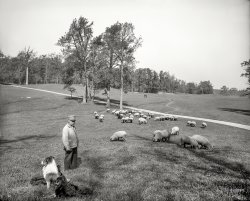
- Brooklyn Catholic School: c. 1910
- ... Catholic school in the old Borough Hall section of Brooklyn, N.Y. On the classroom blackboard is written "Month of the Holy Souls" ... Posted by weegee - 09/10/2010 - 7:16am -
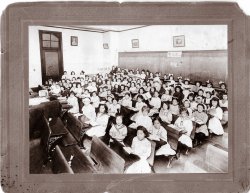
- Brooklyn Teens
- ... because of her rust red hair, poses with two of her Brooklyn neighbors on a street near their home. She is in the center, dressed ... My guess is there are actually four teens hanging out in Brooklyn on this mid 1940's day. Perhaps Jack is taking the picture. Mostly I ... Posted by aenthal - 01/17/2014 - 8:28pm -
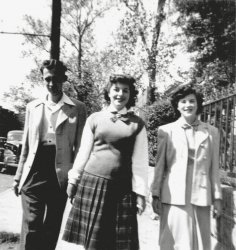
- Brooklyn Halloween: 1965
- ... all costumed up to go trick-or-treating on Hart Street in Brooklyn in 1965. Scanned from a B&W negative. View full size.
... Posted by JoeV - 08/15/2012 - 3:52pm -
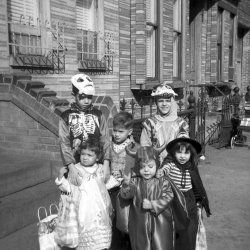
- Falcon in Brooklyn
- ... and on to New York City. I left New York by using the Brooklyn Bridge, and posed the car on Plymouth Street for this view. This ... Posted by Angus J - 10/20/2020 - 8:05am -
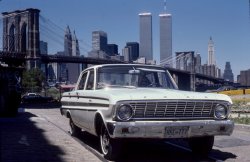
- Band in Brooklyn: 1967
- American Legion Marching Band, on Hart Street in Brooklyn, between Knickerbocker and Wilson, 1967. View full size.
... Posted by JoeV - 06/22/2012 - 9:35pm -
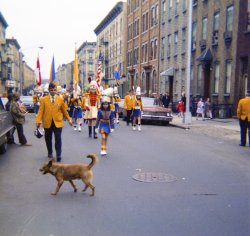
- Brooklyn Bridge
- Brooklyn Bridge, on the walkway...
(ShorpyBlog, Member Gallery) ... Posted by emarg0ed - 06/27/2008 - 11:05pm -
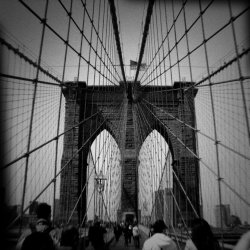
- The Brooklyn Big Four
- Written on the back of this photo: "The Brooklyn Big Four were called Vivian Harper, Theresa Simpson, Sadie Harper, ... Posted by Mattie - 10/18/2008 - 10:04pm -
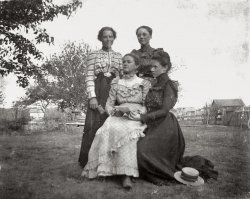
- Sunday in Brooklyn Heights
- ... mother and her sister. In front of their apartment in Brooklyn Heights during the 1940s.
(ShorpyBlog, Member Gallery) ... Posted by pattiayan - 07/26/2011 - 2:42pm -
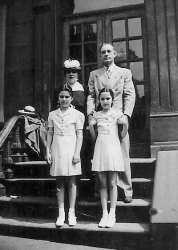
- Manhattan Rising: 1907
- Manhattan circa 1907. "The heart of New York from Brooklyn." A continuation of this view across the East River. Landmarks ... Building under construction, the Park Row building and Brooklyn Bridge. View full size.
Hotel Margaret The two pics were ... Posted by Dave - 12/03/2012 - 10:12am -
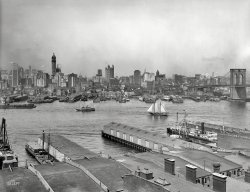
- Williamsburg Bridge: 1902
- New York circa 1902. "New East River bridge from Brooklyn." The Williamsburg Bridge under construction. Detroit Publishing ... Manhattan Bridge was finished.
View is of, not from, Brooklyn Contrary to the caption this photo was taken from Manhattan, not ... Posted by Dave - 08/01/2012 - 5:32pm -
![Williamsburg Bridge: 1902 New York circa 1902. "New East River bridge from Brooklyn." The Williamsburg Bridge under construction. Detroit Publishing Company. View full size.
Loop da loopWhen I opened Shorpy today I only saw part of this picture and thought it was a cool old roller coaster. I'm a little disappointed it's only a cool old bridge.
Former record holderWhen it was built it had the longest span for a suspension bridge. Held that record until the Manhattan Bridge was finished.
View is of, not from, BrooklynContrary to the caption this photo was taken from Manhattan, not Brooklyn.
[It depends on how you look at it. The caption is Manhattan-centric -- saying this is the new bridge from Brooklyn. - Dave]
The missing peopleThere are quite many people in the picture if you look close enough. The scale of the bridge is just so vast that the humans are lot smaller in the picture than you would first assume. Easiest three to spot are on left side of the pier at the front, where are some gravel mounds next to them.
Tiny Tank LocomotiveAppears to be standard gauge.
How did they do that?Engineering projects like this are way beyond my imagination and I usually don't question what I don't understand but how did they build this without any workers? Are they invisible?
Must be SundayI didn't spot a single human figure in the photo.
A Handsome StructureNext to the Brooklyn Bridge, I've always regarded this crossing to and from Manhattan to be the handsomest. Others will say it can't hold a candle to the GW Bridge, but that was built in an entirely different era.
(The Gallery, Boats & Bridges, DPC, NYC)](https://www.shorpy.com/files/images/4a16929a.thumbnail.jpg)
- Children's Room: 1941
- February 1, 1941. "Brooklyn Public Library, Prospect Park Plaza. Children's Room, from balcony." ... View full size.
Shhhhhhhhhhh..... (thank you)
Brooklyn Born and Raised My mother, Dorothy Kaiser, was a Brooklyn girl, born in 1926. She would have been 14 when this picture was ... Posted by Dave - 08/05/2012 - 1:13pm -
![Children's Room: 1941 February 1, 1941. "Brooklyn Public Library, Prospect Park Plaza. Children's Room, from balcony." 5x7 safety negative by Gottscho-Schleisner. View full size.
Shhhhhhhhhhh.....(thank you)
Brooklyn Born and RaisedMy mother, Dorothy Kaiser, was a Brooklyn girl, born in 1926. She would have been 14 when this picture was taken and these kids would have been her contemporaries. What a wonderful glimpse into her childhood world. Thank you. RIP, Mom
1941I was born in 1941, so the serene Brooklyn Library scene is very familiar to one who started school in the late 1940s in New Jersey. There was something comforting about the spic and span nature of our schools then. And, it wasn't our fault that we were overdressed by today's scanty standards. Mom made us wear them! The only clothing I miss from that era was the great stuff from Christmas 1951: Hopalong Cassidy shirt, pants, boots, scarf and belt with silver buckle--with a silver six-shooter cap pistol for after school fun! Those were the days!
The card catalog!Did you catch a glimpse of the long-forgotten card catalog, way over on the right?
I actually have one in the back of my truck right now, purchased this weekend at a Texas antique store and waiting for some handsome hunk to come along and help me move it into my own middle school library ... where the kids will have *no idea* what we're wrestling BACK into a library!
Anne! Is that you?The girl in the hat looks like Anne of Green Gables. Everyone here is so well dressed.
Quiet PleaseI used to hate the way some libraries strictly imposed absolute silence but maybe it's gone too far the other way. The children's section at my local library now has a play area, where kids run around, squabble over toys, and build towers of hard plastic stuff which crash to the floor when they knock them down. Maybe it's good to have quiet places in your life, as well as other places where you can run around and yell and do silly stuff to let off steam.
I can't believeHow open everything is! I work in our local library and our children's room is waaaay overdue for a remodel and is very crowded. We have many more books than this, but this scene is utterly charming!
Don't want to break the magic spell, but...looks posed to me.
[You are a master of the obvious. - Dave]
Boys Wearing Knickers in 1941?I see both boys sitting with their backs to the window are wearing them. I thought 1941 was late for knickers. When did they go completely out of style?
[August 12, 1943. - Dave]
So peaceful!Kids sitting down and quietly reading in a library - I had forgotten what that looks like.
AwesomeI can remember being in this room in late 50's as an early elementary school kid. It was an awe inspiring place. Wonder what it's like now. My dad owned a drug store two blocks away on Eastern Parkway.
50 years laterI've sat and read books in that room 50 years after this photo was taken. It's a beautiful thing.
Those BlindsThe window blinds at the left look odd: is that a relection or some sort of optical trick? Was the photo shot through a glass lightly?
[It is a (probably inadvertent) double exposure. - Dave]
re: Those BlindsMy first thought was that the phantom image of the blinds was a reflection, as if this were taken through a glassed-in balcony or divider. There seems to be one in the distance at the right.
(The Gallery, Education, Schools, Gottscho-Schleisner, Kids, NYC)](https://www.shorpy.com/files/images/5a06265u.thumbnail.jpg)
- The Bowery: 1900
- ... Company. View full size.
A tree grows in Brooklyn But not in the Bowery.
The Manhattan Bridge of 1909 took ... Posted by Dave - 08/01/2012 - 5:36pm -
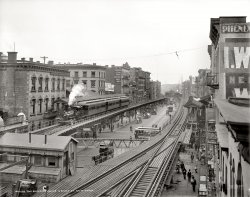
- Brooklyn: c.1926
- Taken on steps of brownstone (believe it was on Union Street) of my mother and her father and sister. View full size.
(ShorpyBlog, Member Gallery) ... Posted by carolelinda - 01/10/2014 - 9:07pm -
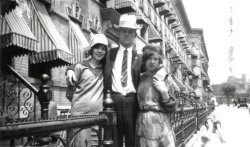
- A Little Game: 1897
- Circa 1897 aboard the U.S.S. Brooklyn . "Evening amusements. A little game." 8x10 glass negative by Edward ... Publishing Co. View full size.
Armored Cruiser Brooklyn A veteran of The Spanish American war.
What a fascinating ... Posted by Dave - 07/29/2012 - 6:14pm -
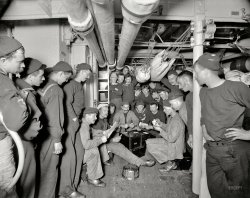
- Municipal Ferry: 1909
- ... River circa 1909. "City of New York municipal ferry Brooklyn , possibly a participant in the Hudson-Fulton celebration." 8x10 inch ... background on the left, in what I am assuming is downtown Brooklyn? Or that parachute-jump looking number showing itself between the ... Posted by Dave - 07/21/2018 - 2:11pm -
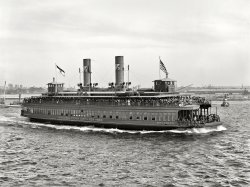
- Dry Dock: 1910
- Circa 1910. "Brooklyn Navy Yard, dry dock No. 4." The battleship is unidentified, but ...
NoDak Looks like USS North Dakota (BB-29) to me.
Brooklyn Navy Yard 2011 I took this photo yesterday from the same spot as ... bricks!
Fire damage The USS North Dakota was at the Brooklyn Navy Yard at least twice in 1910 - in June and again in October. On ... Posted by Dave - 08/08/2012 - 2:03pm -
![Dry Dock: 1910 Circa 1910. "Brooklyn Navy Yard, dry dock No. 4." The battleship is unidentified, but probably not for long. Detroit Publishing glass negative. View full size.
"Pocket Battleship"These vintage warship pictures are fascinating. So this is the USS North Dakota, eh? BB-29, caught with her pants down, as it were. I know little about old battleships, but to my eye this one appears kind of small. Looking at the turrets and gun muzzles in particular, plus the apparent overall size. Since my knowledge is limited I would have guessed this to be a heavy cruiser. I wonder what its dimensions were? Back in my PA days I used to visit the USS Olympia in Philly. I loved the lavish wood paneling in the wardroom and the brass fixtures in the engine room. And I've always liked the "reverse" bow profile of those turn of the century ships. Great stuff!
BattleshipsThis ship is either the Delaware, BB-28, or the North Dakota, BB-29. The distinguishing characteristic is the arrangement of the cage masts and funnels: in the order mast-funnel-mast-funnel. Also, the secondary battery is located in casements on the second deck along the sides of the ship.
North DakotaIt could very well be the USS North Dakota, BB-29. According to Wikipedia it suffered an oil-tank explosion and subsequent fire, and this could be a photo of it being refitted and fixed up after said incident.
USS North DakotaThis is the USS North Dakota. She and her sister-ship, USS Delaware, had a second funnel behind the mainmast while the next two dreadnoughts in the US Navy, USS Florida and USS Utah, had two funnels inside of the masts.
The USS North Dakota also had three stripes on the second funnel whereas the USS Delaware only had two.
I'm still trying to ID the pre-dreadnought docked beyond the warehouse.
USS FloridaThis could be the USS Florida (BB30) which was launched in May of 1910. The USS New York (BB34) and USS Arizona (BB39) were launched subsequently in 1912 and 1915, respectively.
[This ship looks like it's been around the block a few times. - Dave]
Or around the Horn a few times. I should've noticed that.
Sisters, Not Twins Delaware and North Dakota looked the same from the outside, but the former had reciprocating engines and the latter had turbines. Reciprocating engines had better fuel econmy in this period (before reduction gears) while turbines were less vibration prone and could produce more power in the same volume. In this case the engines seem to have been rated the same and therefore the piston engines' better efficiency seemed to make them an obvious choice, leading to a few later US battleships being engined with recips. The British converted to turbines in Dreadnought (1906) and never looked back.
NoDakLooks like USS North Dakota (BB-29) to me.
Brooklyn Navy Yard 2011 I took this photo yesterday from the same spot as the original. There have been crews here attempting to clean up the area around this dry dock and make it into more of an attraction. The water hasn't been drained for years, but the dry dock on the other side of the building on the left (featured in a previous post) is one of the oldest active dry docks in the country. The Navy Yards is an amazing place to work and to visit. Tours are offered every weekend and it's a great thing to check out if you are in the NYC area.
Delaware Class BBChecking through the photos I could find, I believe this is either the Delaware (BB28, launched February, 1909, commissioned April, 1910) or North Dakota (BB29, November, 1908, April, 1910). One identifier to me were the low mounted casement 5 inch guns.
Also of interest and something I had not seen before is the large below water port towards the bow. This I believe is the starboard 21 inch torpedo tube.
USS Delaware/USS North DakotaI think it's either the Delaware (BB-28) or the North Dakota (BB-29). The bridge and forecastle match the Delaware class. They were both commissioned in April 1910 and went on a cruise to Europe that November, so it could be either.
Can anyone identify the battleship in the right background?
The other battleshipLooking at the photo I notice that the turret does not have the squared, boxy look turrets have in other classes but rather angle upwards from gun ports to the rear of the turret.
Looking at photos of the various battleship classes circa 1910 shows only the South Carolina class (South Carolina, BB26 and Michigan, BB27) having this angled turret armor.
The South Carolina class was the first to have the cage type masts and also the first to superimpose the turrets, ie, putting a turret directly behind and above the other changing battleship appearance to what we are most familar with.
An Amazing PictureI have been through many dry docks in my military service but this amazing on many aspects. One being the year and the size of the ship. Modernization and technology was starting to take effect as we know it.
Dry docking 1910 and 2011 -- not much difference.
Whoa! That's a lot of bricks!
Fire damageThe USS North Dakota was at the Brooklyn Navy Yard at least twice in 1910 - in June and again in October. On September 8, 1910, an oil explosion on board killed three sailors, and put the ship at risk. Six members of the crew were awarded Medals of Honor for their heroism in the immediate aftermath of the explosion.
And today it looks likeIt just so happens I took a tour of the old Brooklyn Navy Yard a few months ago. I believe that this is either the same dry dock or the one next to it. The "innards" cranes, tracks, etc... have been replaced over time.
Additional photos of the dry dock in its present state are here.
UmmmIf this is the Brooklyn Navy Yard, why is th Williamsburg Bridge on the LEFT? Shouldn't it be on the right? Or has the yard shrunk about a mile in intervening years?
[The camera is facing northeast into Wallabout Bay, and the bridge is where you'd expect it to be -- straight ahead and a little to the left. - Dave]
Ship in the right backgroundThe shape of the turret makes me think it could be a Pennsylvania/Tennessee class armored cruiser, not a battleship.
Hard to tell.
Navy Yard tenant nowI have a studio overlooking this dry dock. It is no longer in use and there are cranes surrounding it that must have been added after this photo. My studio is in the building to in the left of the photo second floor 5th and 6th window from the end.
The Navy YardShortly after September 11, 2001, I looked at some warehouse space in the Brooklyn Navy Yard. The guy that was showing me around had bought the property shortly before. One of the features that he thought might impress me was that it was bomb proof. It seems the Navy built the 6 story structure as an ammo depot during WW2.
AvastIt looks like this modern metal marvel has two old school crow's nests.
The question not answeredWhy are there no identifying markers on the bow? Was it typical not to mark the ships?
Details First the Crow's Nests are probably just that. Remember these ships didn't have radar, so the only way to detect any other ship or objects in the water was visually and the best place to detect things visually is not from the bridge but from the highest point on the ship, in this case the top of the cage mast. You'd send lookouts up, and either have high powered binoculars up there already or send them up with them.
As far as identifying markings on the bow, the don't appear to be in use during this period, at least not in the U.S. Navy. In fact I don't believe they were in use for battleships at the time of Pearl Harbor. I'm given to understand that they'd have their names on the stern in brass letters, but that was pretty much the only obvious identification from off the ship.
Battleship in backgroundMy first guess was way off base. Especially since there is only one aft turret. I'm glad now that one did not get posted.
With one aft turret, two gun positions near the stern (the boxy squares) and a gap between the upgrade cage mast and the rear stack, this is a Connecticut class battleship. I notice a band at the top of the rear stack, and assume this is an identifier but I did not see a photo to pinpoint which of the six ships this might be.
Dakota or Delaware The USS North Dakota had a large open chock built into the side of the ship behind the hawse pipe. The Delaware did not. This is the Delaware. The ship in the background is a Connecticut class battleship.
Cannons - still in use in 1910?Even with the turret mounted big guns, a bit of old school Naval design seems to have remained in place; are those cannon sticking out the sides??
re: Cannons - still in use in 1910?The guns on the side are the ship's secondary armament. In this case they are fourteen 5" guns in casemates. The guns were placed there to deal with smaller ships close in - like destroyers or torpedo boats - that the main battery couldn't depress low enough to hit.
I love Shorpy commentsI always learn something when I read through the comments and I especially enjoy the lack of trolling. Even when someone is corrected it is usually done with manners and grace.
Additional reason to identify ship as DELAWAREIn looking at photos of DELAWARE and NORTH DAKOTA while in this configuration at navsource.org, I spotted an additional reason to identify the ship as DELAWARE. A close look shows that the pole mast atop the after cage mast is mounted on the *forward* side of the mast on DELAWARE and on the *aft* side on NORTH DAKOTA. This ship appears to have the pole on the fore side, hence more likely to be DELAWARE. Funnel stripes can vary from year to year so are not as reliable by themselves.
(The Gallery, Boats & Bridges, DPC, NYC)](https://www.shorpy.com/files/images/4a25635a.thumbnail.jpg)
- Baseball News: 1952
- September 1952. "Brooklyn Dodgers manager Charley Dressen the locker room with Jackie Robinson." ... the Sears, Montgomery Ward or Penney annual catalog.
Brooklyn (Trolley) Dodgers What kind of a name is "Dodgers" for a baseball ... Back when electric streetcars were first introduced to Brooklyn, there were so many routes and streetcars that residents of Brooklyn ... Posted by Dave - 10/20/2020 - 11:12am -
![Baseball News: 1952 September 1952. "Brooklyn Dodgers manager Charley Dressen the locker room with Jackie Robinson." Acetate negative from photos by Arthur Rothstein for the Look magazine assignment "Charley Dressen -- Genius Along the Gowanus." View full size.
The original Amazon!Back pages of daily newspapers -- ever changing and updated products for mail order, unlike the Sears, Montgomery Ward or Penney annual catalog.
Brooklyn (Trolley) DodgersWhat kind of a name is "Dodgers" for a baseball team? Back when electric streetcars were first introduced to Brooklyn, there were so many routes and streetcars that residents of Brooklyn became known as "trolley dodgers". In the early years there were quite a few related deaths. The baseball team eventually adopted the nickname. The full story is here.
It looks like the ad for the Auto Safety Signal is a device to go in the rear window of a car. Is it an early type of turn signal / brake light?
Standards then and nowImagine a major league locker room looking like that today.
The other guy in the picture, Charley DressenCharley Dressen was an NFL quarterback, as well as a major league third baseman. Pretty impressive for a man 5 feet 5 inches tall and weighing 145 pounds.
TrafficatorsYeah, I can imagine what the Auto Safety Signal was. Somewhere in this house, in a room I cannot currently access, I have an anthology of John Updike's early short stories. In one of them, circa 1951-1952, a character brags that his new car has "directional signals". I think those would be the blinky-blinky things we now take for granted. Before that, there were
trafficators. Or, as I learned to call them from VW magazines in the 80s, semaphores. No driver trained in the last 60 years would have any idea to watch out for those.
I had to look it up to be sure I hadn't imagined it. This is from the 1978 JC Whitney catalog, bought a few years ago on eBay, in a fit of childhood nostalgia.
Auto Safety SignalHere is a reasonable explanation of the device in the ad. I recall them from my misspent youth. I opted for the Wolf Whistle (A guaranteed girl getter they said)
"Your idea for a light that indicates a car is decelerating has merit, but I’m quite sure it’s been done before. I seem to remember an accessory that resembled a small traffic light, with red, yellow and green lenses. It was to be displayed in the rear window, with the red light wired to the car’s brake lights and the yellow and green to a vacuum-operated switch connected to the intake manifold. High vacuum (closed throttle on deceleration) would activate the yellow light, and low vacuum (wide or partially-open throttle) would show green. As I recall, you could buy them in accessory stores such as Western Auto, or order from the legendary J.C. Whitney. Whether the device was patented, I don’t know."
https://www.oldcarsweekly.com/features/qa-with-kit-foster-august-30-2012
My favorite team in the 50'sMy favorite player on this team was Gil Hodges, arguably best fielding first baseman of his time and a great power hitter. He also managed the New York Mets to the championship in 1969.Finally in the baseball Hall of Fame.
But Where?Dodgers are wearing their road grays here, and in September 1952 were only away to play that month in three stadiums: Shibe Park in Philly, the Polo Grounds in NYC and Braves Field in Boston. First guess, based on LOOK magazine assignment was New York, but almost 100 percent sure it's Boston, as the Braves home locker room photos of the era show the same pull-down single pane windows (great air flow-not!) and the small lockers below them with personal item numbered bins above. Chalked on for the visitors in this photo. Braves Field, long gone for baseball, still lives on as a part of Nickerson Field for Boston U sports.
[New York. That newspaper is the New York Herald-Tribune. - Dave]
(The Gallery, Arthur Rothstein, LOOK, NYC, Sports)](https://www.shorpy.com/files/images/SHORPY-07986u.thumbnail.jpg)
- Navy Yard Newsies: 1903
- Circa 1903. "Sands Street entrance, Brooklyn Navy Yard." With a flock of newsies, and Lewis Hine nowhere in sight. ... Street in the neighborhood now called DUMBO.
The Brooklyn Dodgers And the newsies would be among those who dodged the trolleys in Brooklyn.
The Navy Yard Today This is now the entrance to a vehicle ... Posted by Dave - 08/20/2012 - 9:53am -
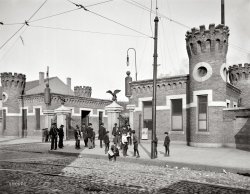
- Daily Eagle: 1916
- 1916. "Brooklyn Daily Eagle." The newspaper's Washington bureau at 608 14th Street ...
Victrola I believe it first said "Victrola."
Brooklyn Daily Eagle The Brooklyn Public Library has digitized the 1841-1902 Brooklyn Daily Eagle. ... Posted by Dave - 08/13/2012 - 6:10pm -
![Daily Eagle: 1916 1916. "Brooklyn Daily Eagle." The newspaper's Washington bureau at 608 14th Street N.W. Harris & Ewing Collection glass negative. View full size.
The ResidentsHoly Kiss of Flesh, I see an eyeball light hanging over the door.
FortuneIs that one of those fortune telling machines below the Tait & Co. sign?
I need super-visionDoes the lower lettering on the optician's door really say "Krypton Lenses"?
Also, I can't quiet make out the lettering on the sign above the Tait's sign -- "Hunt's Men's ___"?
[The signs are for the Hunt's News Bureau and Kryptok Lenses. - Dave]
Cars, Steps, SignsAnother great shot full of period details. That's a 1915 or 1916 Ford on the right. I wonder where that eagle figure is today? And I love those (cast iron?) steps. Lots of "collectibles" like the signs and the thermometer, too. Wonderful things.
Gatsbyesque Glasses exactly like those of Dr. T. J. Eckleburg's are in the window. Also, what fun it would be to read the menu of La Parisienne to see the prices.
Efficiency!I can buy some insurance; sell my house; advertise in the newspaper; get my hat blocked, my suit pressed, and my shoes shined, and my glasses fixed; and cap the day off with a nice roast at La Parisienne. Who needs the mall?
Mystery of the Hatter SignThe "Victoria Hatters" sign seems to have been changed--in both instances--as though someone was correcting a misspelling, or maybe a previous name. I can make out another letter beneath the "O"in the bigger sign. I wonder what the story is behind that?
Blocking HatsI was just thinking the other day how hard it was getting to be to find a good hat blocker.
Victrola AgainThat seems probable; the spacing between the I and A is big enough for the horizontal line on a capital L, which has since been removed/hidden.
[That looks like an E under the O. Which would rule out Victrola. - Dave]
VictrolaI believe it first said "Victrola."
Brooklyn Daily EagleThe Brooklyn Public Library has digitized the 1841-1902 Brooklyn Daily Eagle. Fascinating reading!
Mad HatterI wonder if you could get you hat cleaned and blocked at Victoria's? I don't think their signs mention it.
The SpecialistSo it wasn't just anyone doing hat cleaning and blocking. It was Steve Diamond!
Photographic Services?Do you think the sign along the bottom of the window of the optical business may advertise photographic services? Is this a sideline of the optical business or of the newspaper (could fit either)?
[The sign says "photographic supplies." - Dave]
Zoom please?Can we get a close up of the eyeball sign? I can't make out what it says around the eyeball.
["Geo. A. Baker." - Dave]
Sign TheoryI would guess that it may have been a foreign surname that was painted over to anglicize it to Victoria. The weird spacing of the I and A may indicate the I was carved out of an L or something?
In Houston there was a bar called the Velvet Elvis that featured a cheesy painting on velvet from Mexico of the King. His estate sued and the court ruled in its favor. The bar rearranged the letters to the extent possible and it is now called the Velvet Melvin.
Suits PressedI guess you have to wait in your skivvies while they press 'em.
Walt WhitmanAmong the many distinguished names associated with the Brooklyn Eagle was Walt Whitman, editor from 1846 to 1848. This was years before Leaves of Grass.
(The Gallery, Cars, Trucks, Buses, D.C., Harris + Ewing, Stores & Markets)](https://www.shorpy.com/files/images/07322a.thumbnail.jpg)
- 8th Avenue Elevated: 1905
- ...
[The car chase in that 1971 film was shot in Brooklyn; the Manhattan tracks seen here were gone by 1940. - Dave]
Why ... Posted by Dave - 03/21/2023 - 11:55am -
![8th Avenue Elevated: 1905 New York City circa 1905. "The Elevated, Eighth Avenue and W. 110th Street." 8x10 inch dry plate glass negative, Detroit Publishing Company. View full size.
Old meets newI superimposed the Google Street View over the Shorpy image to see the changes around the building on the left.
Don't jump !!As they say, there's only one chance to make a first impression, and you don't want it to be in the pavement: the (in)famous Suicide Curve.
Reckitt's BlueAn early manifestation of the consumer-goods conglomerate Reckitt Benckiser:
Spectacular PhotographWhat an impressive perspective and composition.
The foreground cobblestones taking an important part of our attention.
The use of above ground rail is such a good conserve of space. The ground footprint of the support stanchions is very small in comparison to the benefit gained of mass transport without congestion.
This idea should be implemented more today to ease traffic chaos on choked arterial roads. A second level can carry vehicles and/or trams/trains via point to point destinations.
Much less intrusive than demolition of huge swathes of buildings to create more lanes.
Is this the same Elthat appeared in the thrilling car chase sequence in "The French Connection"?
[The car chase in that 1971 film was shot in Brooklyn; the Manhattan tracks seen here were gone by 1940. - Dave]
Why Here?After reading about the numerous suicides at this location, I found myself asking "Why here?" Wasn't the elevation of the entire El the same height as at this spot? Why did so many choose to jump only from this curve?
[This particular curve (actually two curves, shaped like an S) was the highest part of the IRT elevated line. - Dave]
(The Gallery, DPC, NYC, Railroads)](https://www.shorpy.com/files/images/SHORPY-4a12612a.thumbnail.jpg)
- Massachusetts: 1898
- ... and ropes in place and there you go.
High and Dry in Brooklyn Brooklyn Navy Yard dry dock, probably early September. Giddy patriots line up ... Posted by Dave - 08/03/2012 - 4:06pm -
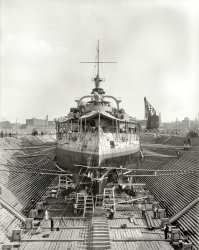
- The New Bohemians: mid-1940s
- ... with three classmates, at some park or botanical garden in Brooklyn, New York near the end of World War II.
Please propose How I ... location, and there are obvious clues for people who know Brooklyn. So many more people view the main gallery than the member gallery ... Posted by aenthal - 12/15/2017 - 8:46pm -
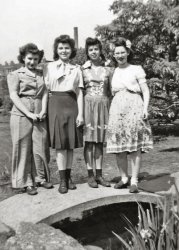
- The Loneliest Yard Sale: 1975
- ... any more they happen to have.
Come to Williamsburg, Brooklyn and all this crap will be overpriced in vintage boutiques for all ... Posted by tterrace - 09/29/2011 - 6:21pm -
![The Loneliest Yard Sale: 1975 My brother and sister-in-law hold a rather minimalist yard sale on a hazy day in the lot behind their apartment on Seabright Ave. in Santa Cruz, California. A later photo shows them gloating over a thin stack of mostly one dollar bills, so apparently they were gratified at the results. Thirty-five years later, some of their items may have gained in desirability. What would you purchase now (if anything)? I spot some vintage, even iconic, vinyl, plus a cool table radio. Neither my 1972 Datsun 1200 nor their Fiat wagon were on the block. The round table was off-limits too, I think. Cat is named Rasha; doggie is someone else's. 35mm Kodacolor negative, Konica Autoreflex T with Hexanon AR 35mm f/2.8 lens. View full size.
I spyBob Dylan - Blonde on Blonde. I'll take it.
What were the seedlings?Cuttings from houseplants? Or seed starts?
Cathode RayI'd take the TV and the picture tube next to it, maybe the old radio too!
Egg-TrackI just noticed the box under the clothes, for a Mod style, egg-shaped 8-Track player.
I have one of those!
I Want YouYes, I want to go through that box of LP records. I see a copy of Bob Dylan's "Blonde On Blonde" on top! Maybe it's the mono version!!
I'll make an offerOn that round coffee table, which appears most likely to be a 1950s Heywood-Wakefield wood top with bent bamboo legs. I have the side table that goes with it and it would look great in my sunroom. The table top radio looks to be brown, marbleized Bakelite and I think the same exact one now sits on my husband's desk. Also very collectible.
Not much else to tempt me because they are too young; they haven't had a chance to really accumulate "stuff." Had they been about 60 and unloading, I'd be cleaning up everything in sight, which reminds me of a recurring dream that I have often--where I am the first one at the very best garage sale of the oldest junk. I wish I HAD gone to more garage sales back in the 70s!
Yes --I think I'll take the radio -- I already have "Blonde on Blonde" in wax.
RADIO!!I collect old tube radios, would love to have the old radio. Wonder where it is today? (If your brother still has it, tell him I'll pay top $$)
ColorfulThose cars, though not for sale, look to be in a desirable shape --- if only there were real time-traveling available.
The Yardsale TapesNobody's mentioned that you can also see a copy of the Band's "Music from Big Pink," whose cover art was painted by the man whose picture is in the box just below it.
DarnNo screw-mount Visoflex lenses. Oh, well, better luck next time.
Sasha kittyI hope she wasn't on the block, and that the carrier is a spare. Otherwise, I take a pass too, even at the same age of sil and bro. I have always liked the old stuff.
I marvel at the young eyes looking at these photos because even with a magnifier I need your words to direct me.
Do they have any more radios in the house?I'll take that tube radio and any more they happen to have.
Come to Williamsburg, Brooklynand all this crap will be overpriced in vintage boutiques for all the new yupsters moving in.
I'll take the shoes.Some well made funky vintage shoes would be nice.
An appreciationtterrace
Thanks for another wonderfully evocative portrait of life in the 70's. I come to this site almost every day hoping that you've posted something new. Your pictures bring me back to a time when we were young (relatively) carefree and the world seemed full of possibilities. It seems such a short time ago. Great work. Please keep posting.
Lyle
Back-orderedHow much for that fancy over-the-toilet storage unit in 1970's green? My local home improvement store has been out-of-stock for about 35 years now.
I see you thereI like this photo because the photographer is visible in his absence -- the black stool you were sitting on, the third cup of coffee on the table.
Harvest Gold or Avocado GreenThe two cars are the either/or colors of every refrigerator, dishwasher or washer/dryer combination in every 70's home!
Avocado anyone?I had an avocado colored refrigerator which closely resembled that Fiat wagon. The refrigerator was faster in the quarter-mile though.
Peas, corn and carrotsThe '70s were a time when most new cars seemed to have been painted the color of vegetables.
Car Color ReduxIn response to Rob's recent post about car colors named after vegetables in the '70s (how about "eggplant" these days?) -- color names could also be very whimsical, and not necessarily vegetable-related.
A college mate of mine had a circa 1972 Ford Maverick, painted "Anti-Establish Mint." I kid you not!
Slept in!That's another great garage sale [as we call them here in Australia] that I've missed. I must get up earlier... Those LPs - how much for the lot?
Not the carI'm the age of those people, so I had most of that same stuff in 1975, including the sweater that your sister-in-law is wearing. My car in 1975 was a Fiat 850 Spider and it was usually out of commission because of starter problems, so I rode a bus to work most days.
Today I would pay good money for that nice little Chinese checkers board in front of your brother. Cheap or not, the game is fun and I like the looks of that one.
Lots of lost memoriesThe weather was drunk outside a lot for me in the early 70's.
Datsun!I find the Datsun product extremely desirable. Any other pics of that one? I remember one a year back or so. Maybe the Fiat or another model close to it.
Roof RacksI spot a set of roof racks in front of the round table. Somewhat adjustable to the width of whatever vehicle they were to be mounted on. Wouldn't be very usable today as the pads needed a rain gutter to mount to. These have been replaced by the modular units from makers like Yakima and Thule. If I remember correctly ours were purchased at Montgomery Ward.
We used to use our set on the old family wagons to haul a canoe or two. Many fond memories of the trips we made to get them in any water larger than a farm pond be it a lake or river.
Nice rackHow much for the clamp-on roof racks for my car? My dad had a pair that we used to carry the jonboat fishing. I hadn't thought of those things for years!
tterrace respondsALB: You can also see my Datsun here.
xpurg8d: That's not Chinese checkers, but Aggravation.
Hillary: I'd never noticed that evidence of my obvious absence!
Lyle Green: Thanks!
Thanks to a couple folks for identifying those things as roof racks. Now, for bonus points, spot the t-square.
I spy with my tiny little eyeOkay, that might be too regional. The T-square should not be under shoes even though I haven't used one in the 16 years that I have been a professional draftsman (since this is Shorpy, Draughtsman).
Now, for bonus pointsUnder the shoes on the table to the left.
How much for the clock radio?The white one on the same table as the old table radio. The kind where the numbers tumble down. They were quite new in 1975 weren't they?
The board gametterrace: Thanks for the name of the game I mistook for Chinese Checkers. I don't know how I missed that one -- I'm a lifelong lover of board games -- but the 70s was a pretty busy time for me and I didn't get to play much during that time. I googled it and it looks like a fun game, so I'd still make an offer.
Tint campOther car colors from '70s Australia. Lettuce Alone, Plum Crazy and Orange Utan.
AggravationI know that this is a reply to an old post, but I wanted to comment anyways.
That Aggravation game looks like the four player version where the colors are printed on the box and you have to set the board on the box so that it sits over the right colors. My parents would play this version with my neighbors every New Years Eve.
The version I got as a kid is the six player Deluxe version that came out in the early 70's. It is a fun game, my wife, I, and friends just had last played this last winter.
If you pick up this game, try to find one at a garage sale of some place. The new versions still sold are all "modernized" with cheap plastic marbles and psychedelic paths for the marbles, which to me leaves a lot to be desired.
Good old memoriesYou had a Fiat 128 Familiare!
I can remember the 128 (and above all the 127) very well. In the 70s, particularly in South Europe, like Spain, Portugal or Italy, they dominated together with the FIAT 500, Mini, Renault 1100, the roads. The 128 Familiare (3-Door Station Wagon) though, was a rare animal.
The Fiat 128 was one of those long-lasting models, produced from 69 to 85 and in the former Yugoslavia they continued until 2003(!). At the same time it was the base for many models produced around the world, at Zastava (Serbia) or SEAT (Spain), for instance.
Your model seems to be a 1975 (launch: Nov. 1974) FIAT 128 3-Door Station Wagon in North America US-Trim (Rectangular side reflectors and US front and rear bumpers). It featured a 4-speed manual power-train (very short 1st and 2nd with a tremendous lack of precision after a while), with a, noisy, 1290 cm3, 4 cyl. inline engine, with sporty 63 HP (in 70s Europe not so bad for such a small car). The original stock roof rack gave it a real nice luxurious touch.
I'd love to have one now.
(ShorpyBlog, Member Gallery, tterrapix)](https://www.shorpy.com/files/images/yardsale.thumbnail.jpg)
- Bridge in Progress: 1908
- ... years ago I climbed one stormy night to the top of the Brooklyn side tower of the Manhattan Bridge. That was done with the help of a ... their bravery enables me to drive across.
From Brooklyn Based on the piers on the opposite short this appears to be looking ... Posted by Dave - 09/12/2011 - 5:58pm -
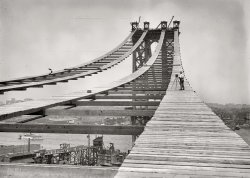
- Winter Games: 1941
- ... Administration. View full size.
'Board in Brooklyn According to "Samantha Brown's Places to Love," an enterprising couple have opened a massive indoor shuffleboard court in Brooklyn and are having to turn people away. Shuffleboard has become "big" ... Posted by Dave - 09/24/2019 - 8:41pm -
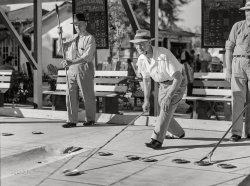
- 'Hot Dogs': 1920
- ... Ebbets Field." This was Game 2 of the World Series between Brooklyn and Cleveland. Bain News Service photo. View full size.
... unfortunately, here's what stands there today:
Brooklyn Dodgers fan joke Vendor: "Hey, COLD beeah heah, COLD beeah..." ... Posted by Dave - 10/01/2020 - 5:19pm -
!['Hot Dogs': 1920 New York, October 6, 1920. "Baseball -- 'Hot dogs' for fans waiting for gates to open at Ebbets Field." This was Game 2 of the World Series between Brooklyn and Cleveland. Bain News Service photo. View full size.
ClevelandCleveland was in a World Series?
(Oops, sorry. Cheap shot.)
What a difference 90 years makesWhy aren't any of the fans wearing Dodgers or Indians uniforms or logo-wear? What about baggy shorts, backwards baseball caps, or tribal tattoos? What about corporate sponsor logos? Finally, I'm not sure what's in the hot dogs, but I know that the lemonade is sweetened with real sugar, not high fructose corn syrup.
"Real" LemonadeI dunno. If it was anything like circus lemonade, I think I'd pass.
The recipe for circus lemonade has not changed from that day to this. A tub of water — with no particular squeamishness regarding its source — tartaric acid, some sugar, enough aniline dye to give it a rich pink, and for a finish some thin slices of lemon. The slices of lemon are known as "floaters," and any which are left in the tub at the close of a day's business, together with those which have come back in the glasses, are carefully saved over for the next day's use. In this way the same floaters may appear before the public a considerable number of times.
-- From "The Ways of the Circus: Being the Memories and Adventures of George Conklin, Tamer of Lions" (1921)
What's thatAny idea what the gizmo is next to the two coffeepots? The can with the thin tube going down next to the coffee pot.
[It's the fuel reservoir for the stove. - Dave]
It's refreshing to NOT see all the extraneous bits and pieces now deemed necessary. Part of the good old days that really was good! All very dignified and proper.
Hot and ColdImagine that. Guilt-free hot dogs and ice cold lemonade. I wonder how much they were? Guys get all the fun, evidently.
Anti MemeOr I thought it was deja vu...but I checked; this is at least the fifth time for the "no baggy shorts, tattoos, thuggish scowls" meme. At the risk of stating the obvious, you're stating the obvious.
The Dodgers' Real HomeAnd unfortunately, here's what stands there today:
Brooklyn Dodgers fan jokeVendor: "Hey, COLD beeah heah, COLD beeah..."
Fan: "Hey yo, gimme a bottle!"
Vendor: "You want it for drinkin' or t'rowin'?"
The Robins won the game, but Cleveland the Series 5-2The Brooklyn team was called the Robins then. They won the game 3-0 behind Burleigh Grimes pitching, but the Indians won the World Series, 5 games to 2. The Series was best of nine then.
(The Gallery, G.G. Bain, NYC, Sports)](https://www.shorpy.com/files/images/18463u.thumbnail.jpg)
- Keg Run: 1943
- ... supply of Trommer's Beer & Ale.
Trommers of Brooklyn Trommers Brewery was just outside the gates of Evergreen Cemetery in Brooklyn. (They had a second brewery in Orange NJ)
Famous for their all ... Posted by Dave - 03/08/2013 - 1:31pm -
![Keg Run: 1943 March 1943. "Beer truck on 44th 39th Street and Sixth Avenue." Just turn right at the Sandwich Shanty. Another truck shot by John Vachon. View full size.
Labor Stage, or Princess TheaterThe caption says 44th St, but the street sign on the left says 39th, home of the Labor Stage.
[Caption amended, 70 years after the fact. Better late than never! - Dave]
Roll out the barrelHaving spent my first 22 years in the northeast and being a Polish child in the 1940s & 50's, Sundays were the day that we were forced to listen to polkas on the radio from after church in the morning until about 2 or 3 in the afternoon, (and yes, we did have roast chicken most Sundays-I can even smell it now). I remember particularly the Victor and Sophie Zambroski show in Ct. that went on for hours and they must have played every polka ever written although they all sounded alike to me. Anyhoo, the exposure made us use our imagination (as radio people did) as they all had lyrics in English and so in our minds it was like our own individual mental "hit parade" envisioning how each song would be acted out. The beer barrel polka reminded me of a massive Polish party with the men rolling out ongoing parades of beer kegs, ladies dancing polkas together (since the men did not) and kids just having a riotous good time being crazy and eating themselves to regurgitation. In this picture, with the loosely-packed beer barrels, if those top rows started rolling off, the people getting hit with them would not find it at all enjoyable as I had imagined. Therefore this picture, once and for all, tells me I should re-imagine my childhood fantasies since rolling out barrels may have serious consequences. Sorry to ramble so much, it is a slow day.
Traffic JamThen and now. A few of the original buildings have survived.
Traffic patternsUnlike the time of the photo, W 39th Street is now only a left turn from 6th Ave which hasn't carried 2-way traffic in decades. The site of the two shorter buildings is now a Residence Inn. The next 2 buildings down 39th are still there.
That taxilooks like the famous yellow cab that was in many many movies and ended up at the U.S. pavilion in Montreal at EXPO 67. Movie buffs will have seen that cab in many movies from the 1940's to the 1950's, where is it now?
Trommer'sA little bit of history:
http://www.rustycans.com/COM/month0405.html
Wartime CounterespionageThe caption could have been intentionally misidentified to help protect the nation's wartime supply of Trommer's Beer & Ale.
Trommers of BrooklynTrommers Brewery was just outside the gates of Evergreen Cemetery in Brooklyn. (They had a second brewery in Orange NJ)
Famous for their all malt beer, (no corn sugar used in the conditioning.) They would be the vicitms of the brewery strike of 1949, when their chemists were locked out of the brewery and their yeast strain died. It was said to never taste the same again.
Wooden barrels in 1943, steel kegs came in after prohibition, but if they used steel, they were sent to the scrap metal drives for the war effort, although they may not have made the change yet. (Rheingold in Brooklyn was using wood kegs in '43.) There was such a shortage of beer kegs after prohibition that beer was imported from Germany, and the kegs were part of the deal.
There's a new Marriott Hotel on that far corner now.
Not since 1957Like most odd numbered Manhattan streets, 39th is one-way westbound. As far as I know it's always been that way. The beer truck therefore must be heading southbound on Sixth Avenue, which would have become impossible 14 years after the picture's date when Sixth Avenue became one-way northbound.
The building with the mansard roof on the corner of Sixth and 39th is gone now, as is the building next to it with the Labor Stage sign; the Marriott Residence Inn now occupies the site. The building across 39th housing the Sandwich Shanty also is history. Still around, however, are the two buildings on 39th to the right of the Labor Stage building. The first one is 108 W. 39th, built in 1928, while the second, lighter-colored one is part of a much larger building with the address of 1400 Broadway.
Two other vehicles from the good old days . . .Taxicab looks to be a Dodge (or at least a Chrysler product) of early 40's vintage with skylight - likely with leather upholstery as required by the City of New York for ease of clean-up. In front of the taxi appears to be a coal delivery truck, my guess a Mack AC Bulldog with chain drive - that chassis saw service during WWI. I was born that year, and all those vehicles were still in service well into the 1950's.
When Cabs had Legroom!Back when taxis had rear legroom to spare! There are probably even a couple of jump seats in that Chrysler taxicab.
Calling That CabI agree that the taxi is a Chrysler product, specifically a 1941 DeSoto, both per the design of the taillights and the front trim, as well as the fact that DeSotos were THE most popular make for American big-city taxicabs in the 1940s. Their Chrysler, Dodge, and even Plymouth siblings were very similar mechanically and in body style at the time, but DeSoto got the nod from the cab companies the most often. Watch for the preponderance of DeSoto taxis in photos and movies from the 1940's.
Trommer's Evergreen BreweryTrommer's advertisements from 1915, 1913 and 1909.
Oh, the history ..."I remember particularly the Victor and Sophie Zambroski show in Ct. that went on for hours"
Victor Zembruski and his teenaged bride Sophie started "Polka Time" (later renamed the "Polish Eagle Show") on WATR 1320-AM in Waterbury, Connecticut all the way back in 1934. Victor became ill and retired in the late 1960's, but Sophie carried on as sole host. Sophie herself retired, and handed the show over to her and Victor's daughter ... in 2008. That is not a mistake. Sophie hosted the same radio show for SIXTY FOUR years. She died in 2010, aged 92.
The Bronx Is Up And The Battery's DownIt's hard to tell, but I believe the cab is a DeSoto Skyview. Betty Garrett drove one in the movie "On The Town" with Gene Kelly and Frank Sinatra. These taxis had a moonroof that opened allowed the passengers to see the NYC skyline. They were sold exclusively by the John Water DeSoto Dealership in Long Island City in the Borough of Queens. A story that I heard many years ago that Water was Walter Chrysler's Son-In-Law but could never confirm it.
Coal truckThats a coal truck in front of the Chrysler taxi. I grew up in Great Neck NY and the apartment building in which we lived was heated by a coal fired furnace. The delivery man would put the coal chute through a basement window, then the super had to move the coal to the furnace which was on the other side of the building one wheel barrow at a time. I look back at that and realize he must have spent most of his time feeding that furnace, and that must be why he smelled like coal!
Thank you PeterMy heartfelt appreciation goes out to commenter Peter who added to "the rest of the story" with his update on the Zembruski family in Ct. I never dreamed they were still on the air there and that Sophie worked on the radio until 2008, when she was 90. It is so good to know that a familiar childhood radio show and family name are still playing that happy music as they did 69 years ago. That is quite a remarkable eye-opener and I had no idea it still exists, even now, when almost everything else about my childhood has become extinct, obsolete and long-gone. Thanks again Peter.
Re: DeSotoI am glad to defer to the posters who identified the taxi as a DeSoto, and also thanx to Mr Mel for indentifying the dealership that sold them. As for the coal delivery truck, our house in East New York in Brooklyn took coal directly to a coal bin within shoveling distance of the furnace - this continued until the conversion to oil late 40's/early 50's. This is a great site, especially for the camaraderie among the posters, and Dave and tterrace, as well!
Trucks & CabsThe Trommer's truck is a 1936 or early series 1937 Federal. There appears to be a lantern or some other object between the left front fender and the side of the hood. It looks like the truck body has an access hatch to the bed so (un)loading could take place or a ramp could be attached. If this door is used for unloading, it could be a pretty dangerous way to remove kegs that could roll easily.
The truck number by the door looks like number 346, but the back of the truck shows this is be truck 187.
The cab is a 1941 DeSoto SkyView, probably a model S-8, modified by Mr. Waters. Printed on and above the passenger door the words "DeSoto SkyView." It looks like there is a NY city cab/hack medallion attached in front of the front passenger side door.
Unfortunately Mr. Waters drowned in his pool in May 1941. Ironically a short biography of him was featured in the April 7, 1941 issue of Time Magazine.
Here is an excellent article and photos of Waters' automobiles.
+71Below is the same view from September of 2014.
(The Gallery, Cars, Trucks, Buses, John Vachon, NYC)](https://www.shorpy.com/files/images/SHORPY_8d26821a.thumbnail.jpg)
- Rockaway Bungalows: 1910
- ... rent a bungalow in the summer months to get us out of Brooklyn for awhile. Great memories.
Rockaway, a kid's dream I ... was a great summer getaway for a working class family from Brooklyn.
Elisa on B 29th Was your grandma named Bessie? I lived in the ... Posted by Dave - 08/04/2012 - 3:56am -
![Rockaway Bungalows: 1910 Vacation bungalow colony at Rockaway, Queens, c. 1910. View full size. George Grantham Bain Collection. Note "front yards" of sand decorated with seashells.
Sand in QueensI wonder if any of the buildings are still standing. Since they are tract of small bungalows, I wonder what company supplied that lot for workers to live in.
Sand in...Queens?! Wow.
[Never heard of Rockaway Beach? - Dave]
BungalowsWere these for living or vacation rentals? They sure are cute. Does anyone know how far from the water they were?
Rockaway[Never heard of Rockaway Beach? - Dave]
Well I've heard of Rockaway Beach here in Oregon. :)
Re: BungalowsThe were seasonal at first. More info at the Beachside Bungalow Preservation Association:
By the 1920s, Rockaway Beach was the poor man's Riviera. It had a six-mile long boardwalk lined with amusements, and thousands flocked to the beach every summer weekend. Many families rented tents for the entire season, while those a little more affluent rented small bungalows. The concept of the bungalow in America was well established by this time as they were built for summer communities on both coasts. The plans could be purchased from catalogues and were designed in numerous styles.
This last remaining bungalow colony was built by Richard Bainbridge in the 1920s. The one and a half story houses all have front porches and pitched roofs. The design and style vary from street to street. Some of the bungalows are in a Spanish Revival style of stucco with wood trim and green the roofs, and others are in an English Tudor of brick. Lacking heat, they were closed for the winter months. The lanes leading to the beach have permanent easements for common access.
As development pressures change the Rockaways, this small district has become endangered. But it would be appropriate to preserve and restore this remnant of past summer amusements.
The yards are super.The yards are super. Send the kids down to the beach to bring back sea shells to decorate with! Talk about a family project.
Rockaway BungalowsI'm pretty sure these are not there anymore. In fact Rockaway Beach today is quite run-down. If you take the A Train out there, these must have been between the tracks and the water, where there are now streets with no houses. Only weeds.
Sadly, most of theseSadly, most of these bungalows are gone, as Doug points out above. There are only a few left, and they face demolition by developers who want to turn the Rockaways into yet another bland housing development. These were vacation homes for folks in Manhattan and the other boros, not company houses for factory workers. How close were they to the beach? How does less than a city block sound? In the Rockaways, as at Coney, Manhattan, Brighton, and other New York City beaches, the streets are set up perpendicular to the beach and are only a few blocks long. The last block actually ends at the boardwalk. Across the boardwalk is the beach. The Ramones were from the Rockaways.
Beach 29th streetMy family rented a bungalow on Beach 29th street until I was around 12 years old. As soon as school was over, my parents would pack up a van and off we went until Labor Day. It was the most amazing summers of my life. No locks on doors, showers in the backyard, fireworks Wednesday nights. My parents belonged to a group called FROGS- Far Rockaway Ocean Goers. The Bungalow owners, Mr. and Mrs. Herman, would let my Dad come before the season to fish. The last time I was there was about 36 years ago. It was so sad to see the destruction of these amazing bungalows. Ours was white and green, and all the furniture inside was painted a sticky tacky gray. My Grandma and Nana lived a few blocks up in a rooming house. It was very sad to watch as these homes burned to the ground. Such a day-gone-by era.
Beach 29th StreetHi!
I am very curious exactly where on 29th Street the bungalow was. I lived on 29th just off Seagirt Blvd. It was a year 'round dwelling. The area was VERY crowded during the summer and VERY empty from after Labor Day until Memorial Day.
Do you have any pictures from there? I would love to see them!
Thanks,
Marc
Far Rockaway refugee now living in Bayside, NY
Rockaway BungalowsThere was nothing better than spending the summer in Rockaway. Most of your family members rented bungalows in the court. Everyone was out every night. The beach was just a few steps away. Fathers came out only for the weekends, even if you lived in Queens...
Beach 107 StreetMy aunts, grandmother and uncle would whisk us away to Rockaway the minute school closed for the summer. We would stop at Weiss's for fish and chips, then drive over the old Cross Bay Boulevard bridge and see the top of the roller coaster and the ocean beyond. In a few minutes we would be at our bungelow in Highland Court, the second one in. We thought we had arrived since we had a hot water heater. It was a great place for kids to grow up. Every day my sister and I would open the window with the sun shining down on us. We would get into our bathing suits and run to the beach, riding the waves until we were dragged out by our relatives.
Beach 106 StreetBetween 1951 and 1958 or so I stayed with my good friend Donald Sullivan and his family in bungalows on Beach 106 Street. I don't remember the court name - if it had one. I do seem to remember Highland Court but this was centuries ago and memory may play tricks.
Sand in QueensA similar group of bungalows still exists in the Breezy Point Coop and Roxbury in Queens. Many have been expanded and converted to year round use now, though some are still used only for the season. They refer to Breezy Point and Roxbury as the "Irish Riviera" due to the strong Irish presence.
B. 29th bungalowsI know EXACTLY where you were. My grandmother too had a bungalow, about 5-6 before the boardwalk ramp. They were on the left side, because on the right side was a parking lot or a building (I can't remember it exactly). But up the block was two hotels - the Regency and another one. They were both owned by the same people - Mr. and Mrs. Hecht, german/lithuanian-jewish folks. If you remember, there was a wooden bridge that connected the two buildings, and the courtyard was shared by the two. The showers were both underneath the front of the buildings behind the, lattice and then common showers/bathrooms in the hallways. There was one public phone on each floor and a television on each floor. When my grandmother could no longer stay in the bungalow (either they were sold, torn down or condemned), she went into the Regency Hotel. She was in the basement which was very cool in the summer. They dodn't need air conditioning.
The last party of the season was Mardi Gras. My grandmother, being on the heavy side, loved to wear blackface makeup and put her hair up with a tied kerchief - she was "Aunt Jemima."
I only wish I had a place like 29th street to bring up my children in the summers. We ended up renting cabanas in Atlantic Beach from when they were little, then moved to Atlantic Beach, but retained memberships at the beach club. We can't get the sand out of our shoes!
Belle Harbor's Bungalows I was searching for a picture of Weiss's Restaurant and stumbled across this site. I found one taken before the war, but was hoping to find one more recently, like late 1950s or early 60s. Looking at the group of bungalows, there were similar ones along the beach 2 rows deep at B129th Street in Belle Harbor, Rockaway. They looked very similar to the ones in the pics if memory serves. I was there last year and although they still occupy the same footprint, most have either been completely reconstructed or torn down and replaced with more modern ones. I recall every summer going to the beach and seeking out the "city" kids here for a few weeks. We made lots of new friends every summer. Then there were the bungalows out on RockyPoint/BreezyPoint.
My mother spent her childhood summers, probably right there in that picture. Her parents owned their own bungalow. I have a picture of it from around 1941. Mom's 83 and I'll have to print this off and show it to her.
Maple Court, Beach 28th st.I've been searching for info on Far Rockaway. I've been strolling down memory lane thinking about my wonderful summers there. My family rented, and we stayed for a total of five summers. The last two were in Maple Court, which, I believe, was on beach 26th or 28th Street. Before that we were in B Court and A Court on 28th. I agree with the posters who spoke of these summers as paradise! I felt truly free there. And yes, nothing was locked up. There was no schedule to keep. Just pure fun. My last summer there was in 1969. I remember this because of the moon landing. We returned home from the fireworks display on the beach and watched it on TV. My grandparents owned a fruit store on the main street, and they stayed at a wonderful hotel called the Manor. My happiest memories from my childhood are from Far Rockaway.
Maple Court bungalowMy family purchased a bungalow at 29 Maple Court in 1969 when I was 9 years old. I too had the greatest memories there. We took so much for granted thinking everyone lived as we did. Now I realize how lucky we were back then. Being able to stroll down the street to the boardwalk, watching the fireworks Wednesday nights, and winning prizes at the arcade games are fond memories. Do you remember the pizza shop on the corner? Because the bungalows were so small and cozy, to this day I prefer smaller spaces. Thanks for letting me relive those memories for just a short time.
The EmbassyWe stayed in the Embassy on 29th Street (right next to the ramp to the beach). Many of my friends were in the bungalow courts between 28th and 29th. We stopped going in 1967 but those were the best times -- those summers were magical. My husband and I went back in 1998. There is a school where the Embassy used to be and nothing much else. I went down to the beach and I cried.
Who were your grandparents?Carolyn, my parents owned the Manor at 2400 Seagirt Blvd (beach 24st). My last summer on Rockaway Beach was 1967 just before I entered the Army. My parents and I moved to South Florida shortly there after. I was 6 miles from the DMZ in Vietnam when we landed on the moon.
Fruit storeCarolyn, if memory serves (pretty fuzzy by now), your grandparents were the Lebowitzes. The fruit store was on Edgemere Avenue just off Beach 24 next to Willy's Market.
If I am right, I am amazed.
The EmbassyMy family had a bungalow on B29th Street on "the ramp" from the 1950s until around 1970.
I got thrown out of the Embassy by the owner because we didn't live there. I bought ice cream at the candy store under the porch of the hotel.
I saw the school, it was a bummer. I remember Lenny's, skee ball, Jerry's knishes, Sally & Larry's pizza, movies on the boardwalk, Dugan the baker, softball games, basketball in the parking lot. I used to sell lemonade to the ball players on hot days. Memories ...
I remember a girl named Cherie or Sherry. She had a boyfriend, Arnie. I used to hang out with Arnie's brother Marvin.
lmc2222@aol.com
Far RockawayI also have childhood reminiscences of Far Rockaway. My family lived in a small bungalow rented for a group of Russians in 1970s (yep, I am Russian, living in Moscow now). I was 3 or 4 years old at that time, so I do not remember much. What I know is that these are one of the brightest memories of my early childhood. My pa said the house was really small. I do not know what street it was on, or if it still exists.
What matters are the snapshots of my memory: me sitting on a porch on a rocking chair, and the arches of the porches, of the same form and shape, go all the way down to the ocean. Me playing in sand, building garages for toy trucks, with other children running from waves that seemed - wow - so really huge. And above all and around all, the salty smell of Atlantic, which is different from any other seaside smell.
Great pity the place is devastated today. Hope that everyone who has ever had good times in Far Rock keeps his own memory snapshots of the place, where it looks as it really should.
Fruit StorePeter, you have an incredible memory! My grandparents were the Leibowitzes. That's such a specific memory. Did you know them personally? I would love to hear about any memories you have of them or the store. Were you a child at the time?
The EmbassyCheri, I can understand your crying. I went back many years ago and was also upset to see the area so demolished. At that time, it seemed the only bungalow left standing belonged to a lady we were all so afraid of on Maple court. She seemed to hate kids (probably we just annoyed her mercilessly!). But going back as an adult, I saw her situation quite differently. The bungalow was all she had, and so she stayed there while everything around her seemed to be destroyed.
Maple Court BungalowLillian, we must have known each other since we were there at the same time, and we were around the same age. I was in the first bungalow on the right, facing the main street. You might remember the pile of junk in front of the house (left by the owner, which we were waiting for them to take away!) Where in the court were you? I remember a girl named Elena, and a boy everybody had a crush on named Eddie.
The ManorWow... your parents owned the Manor! What an interesting and exciting experience that must have been. If I recall correctly, there were an eccentric bunch of characters staying there.
Carolyn! What a great happening!Hi Carolyn,
Glad you found me on Facebook. Your ability to put me together with my earlier Shorpy post was remarkable, so I am posting this for the benefit of "Shorpy page readers."
Your recollections and mine from the 1960's certainly attest to how great having the internet and pages like Shorpy's are. (Shorpy..thank you!) The fact that I remembered your grandparents is somewhat unique cause I can't remember anyone else's grandparents from way back then, other then mine. I must have really liked them and was destined to cross your path again. I remember sitting and talking with them on porch of the Manor in one of those green rocking chairs. They were "grandparent" types, had a European accent like most grandparents back then, and easy to be comfortable with.
Just to put things into focus, I am now 63. That was back when I was 16 or 17 and younger, but your grandparents returned to the Manor for quite a few summers in the 1960s. How could I have remembered your grandparents' name? I too am amazed and flabbergasted.
Memories of Far RockawayYes, this website is truly wonderful for allowing us to stroll down memory lane and recall the sights, smells and feel of Far Rockaway... and what an extra treat for me to find someone who actually knew my grandparents. Thank you Shorpy's for allowing us this exchange of information and memories... and thank you Peter for your kindness and your very sharp memory!
Far RockawayMy sister directed me to this site. We stayed in the Jefferson Hotel, right between Beach 29th and 30th, next to the Frontenac. My good friend Faye's grandparents, the Kratkas, owned the Embassy and both Faye and I worked the concession stand which her parents ran.
The memories of the boardwalk are still strong. Not only did we have the luxury of a fantastic beach at our doorstep, we also had nighttime fun. Cruising up and down the boardwalk -- eating pizza at Sally & Larry's, or Takee Cup (originally called Tuckee Cup until the owners got disgusted of painting out the alternate name it always received over the winter months) and listening to Eddie, with his ever-present songbook, sing requests. All added up to good, clean fun.
I left in 1968, went back from time to time, but haven't been back in years. Unfortunately, you can see enough from Google Earth.
My two auntsMy father's two aunts had a bungalow in Rockaway Beach in the late 50's early 60's. It had flowered wallpaper and a musty smell, but it was the most interesting home I have ever been in. I was allowed to leave and explore without my mother's glare. I cannot tell you what food we ate there. I have no memory of meals which is odd. I do remember being bitten by my aunt's dog, which scared me for a long time. I think their names were Bernice and Ruth Cohan. If you have any thing to share please do.
thanks, Mary Donaldson
neversynvr@aol.com
Twin HousesThe houses with the bridge were known as "the twin houses", possibly the Claremore & Edgewater, both owned by the Hechts. I spent the happiest summers of my life there!
Like Cheri, I've wanted to return, but haven't as I know how sad it would be. Better to revisit in memory, sometimes in dreams.
I probably know Cheri (from Arnie & the Joey days) and Les rings a bell, as does singing Eddie...
Marcy
Sand in my shoes on Beach 107thMy mother's family went to Beach 107th in the summers of 1917 through 1929. After the Depression hit they couldn't afford it. I still have photos of that period.
In 1951 our family went down to the Rockaways and rented a bungalow for the season. The courts I remember were Almeida and Holmenhurst.
My dad came only for the weekends, arriving Friday evening. The first thing he did was put on his trunks and head for the beach with me. When he hit the ocean you could see all his cares and worries leave. At night the parents would gather on the porches and play cards, drink a Tom Collins or have a beer and just have a good time.
As a 10-year-old I wondered what was so much fun doing this every weekend. It occurred to me many years ago that boy, did they have it made. Sitting on a porch with a nice summer drink, a cool ocean breeze along with good friends to talk with and play cards with. Life was so laid-back and simple then.
Does anyone remember the doughnut shop Brindle's or the bakery Dudie's? What about Nat's Ice cream shop, where you could get a walk-away sundae. Bill's Deli had the best salads and cold cuts.
Wonderful summers that will always keep me warm in the winters of my aging mind.
Beach 28th Street & A B and C CourtsI too remember the pizzaria on the corner of Beach 28th street. I remember my friends Randy, Shmealy, Risa, Brenda and Jody. I don't remember Shmealy's given name, but I remember he was hyperactive and a lot of fun. Made up a song from the commercials of the time for Halo Shampoo. "Halo Sham-poo poo, Ha-a-lo! Jodi's mom didn't want me hanging around Jody because I blinked my eyes too much. Oh well. HEY: Jody from Beach 29th street who wrote a post here on 11/12/2007 - I wonder if you're the Jody I remember!? I hung around with Risa a lot. I still have a photo of us and my dog Suzie on the porch of my Bungalow. I once disappeared into the Courts of Beach 28th street while walking my dog. I ended up talking to a boy for 2 hours, not knowing my parents had called the police and had an all-out search for me. My father finally found me. I was the talk of the town that day! I hope someone remembers these people or IS one of these people, or remembers the lost girl incident and would like to contact me at orangechickens2@aol.com. It would be wonderful to hear from you!!
Anyone remember dogball?My dad wrote about playing dogball on the beach at 110th Street on his blog at willhoppe.com.
I'm going to show him all of your comments later tonight.
The BungalowsI was born in Far Rockaway in 1942. I lived there for 16 summers. My dad owned a small grocery on B 28th street. It was the best time of my life. Maple Court faced 28th. To me it was a very exotic place. The renters/owners vacationed there, my dad was a workman. We lived in roominghouses with a bath on the floor. One year I begged my dad to live in Maple Court and we got a small apartment in the back of a bungalow there. The bungalows were the BEST.
Rockaway native from HammelsBorn in Rockaway in 1941 at Rockway Beach Hospital. Went to PS 44, JHS 198, Class of '59 from Far Rock. Worked as a locker boy at Roche's Beach Club in Far Rockaway. For two summers I worked in Rockaway Playland. I lived on 90th, where my parents rented out the bungalow in the back of our house every summer. My father at the end of his years as a waiter worked in Weiss's dining room, and the Breakers restaurant on 116th Street.
I met my wife in 1965 at McNulty's on 108th Street. She was from Woodhaven and Breezy Point. We got married in '68. I am writing this on the back deck as we are still enjoying the summer weather here at Breezy. We both still have sand in our shoes.
Our 1940s summersA group of Bronx families spent the summers of the early '40s in a few bungalows. Sundays the working fathers would appear for a community breakfast. We celebrated V-J Day with a parade on the boardwalk. Takee Cup was a part of our diet. A noodle cup to be eaten after the chow mein was devoured. The ultimate hand held food treat.
Beach 25th StreetI grew up in Far Rockaway in the 1960s and 70s. We lived in the Bronx and rented every summer on Beach 32nd Street (now two big apartment buildings -- Seaview Towers). When I was 9 or 10, we moved to Beach 25th year-round. The summers were great -- we didn't wear shoes most of the time.
Every Friday night, "Bingo Al" held a game in the court behind the bungalows, between 25th and 26th. One summmer he had a "Chinese auction" and dressed up in an oriental robe and Fu Manchu mustache and beard.
Many of the residents got seltzer water delivered in bottles at their back porch. They would gather in the evenings out in front of the bungalows and talk and joke. I would lie in my bed, with my ear pressed against the window screen, trying to listen, and also trying to stay cool -- no air conditioning.
Sol "The Cantor" Gerb would play his little electric organ as people sipped their drinks, chatted or played cards. It was like a different world from the rest of New York.
I read where one commenter talked about the bungalows rented for the Russians. This was on Beach 24th Street. They worked at the United Nations and rented a block of bungalows. Every Monday morning passenger vans would show up to take them to work at the UN. We played with the Russian kids. They were a good bunch. I stayed over at one of their bungalows and we had crepes for breakfast. I had no idea what crepes were! I learned to play chess, as the Russians were crazy about it. I recall one time when members of the Jewish Defense League blew up a small BMW belonging to one of the Russians. The news came out and I was in the background, behind the reporter. A sad time for Far Rockaway.
One of the amazing things was the backgrounds of the bungalow residents -- former concentration camp prisoners, Russians, Irish, Jews, some Italians and Greeks, but we all got along so well. A great place to grow up!
At the FrontenacMy family spent summers at the Frontenac from the late 40s until 1957. When I describe it to my daughter, I have to confess it was really more like a boardinghouse. My mother, father and I shared a room that was also the kitchen. Bathroom on the floor, showers were out back for when you came back from the beach. It was great community. Juke box for dancing, card room for gin and mah jongg and the television on the porch.
I loved Jerry's cherry cheese knishes. I remember the movie theater on the boardwalk in the 30's (it could barely be called indoors)
I bought the News and Mirror off the delivery trucks for 2 or 3 cents and sold them for a nickel.
My parents would pay the guy who ran the first aid station under the boardwalk to hold our beach chairs overnight so we wouldn't have to "schlep" them back and forth.
We played softball on the blacktop parking lot on 29th street right off the boardwalk.
My wife, who I did not know then, stayed with a friend's family in a bungalow on 29th street. I think her best memory was playing Fascination.
Best summers everI used to stay at my grandmother's bungalow on B 28th st. in the mid to late 60s. Those were the very best summers ever! Walking just a few yards to the boardwalk and beach, pizza from the store on the corner, hanging with Howie and the crowd there. Playing Fascination for a dime, huge french fries in those cone cups.
If anyone knows the whereabouts of Howie Young I'd love to get in touch with him. My email is belongtoyou@hotmail.com
Hugh McNulty Hotel, Rockaway BeachI am trying to learn about Hugh McNulty's Hotel. I am not sure what street it was on, but there was also a bar in it. Hugh was my mum's uncle and her father came to stay with him and work for him. The time period may have been 1924-1930. I know the hotel was still in operation in 1953, as my grandmother visited him at that time. Any help is appreciated. libtech50@comcast.net
Edgemere memoriesMy family lived many places in the Edgemere section of Far Rockaway (I don't know the exact boundaries of Edgemere, if there were any), but my memories centered on Beach 48th Way and Beach 48th Street. Fantastic place to spend the summers and escape the hell of the South Bronx. I had wonderful Jewish friends and I worried that they would go to hell because they weren't Catholic. Now I laugh as such perverted theology, but back then it was serious stuff.
I loved the beach, the ocean, the starts, the jetties, playing every group game known to humans, going over the the "bay side" to play softball with the "project people" -- those who lived beyond the marshes and spent the winter there.
No doubt about it, the best part of my childhood was Rockaway. Too bad it was taken away from us and to my knowledge, still is just a bunch of sand with no houses where we used to live, right near the boardwalk.
Beach 48th Way, RockawayIn the early 1960s there were two brothers that were lifeguards when my family was there, Dennis and Tom Fulton. Anyone remember them? Also there was a man named Warren who would feed pigeons at the end of the block every day. My parents would rent a bungalow in the summer months to get us out of Brooklyn for awhile. Great memories.
Rockaway, a kid's dreamI remember growing up in Rockaway. We had two boarding houses on Beach 114th Street. When my mom was a kid, Carroll O'Connor, his mom and brother Frank stayed with them. He returned to see my parents back in the mid-eighties and I received one of his last e-mails before he died. I worked my way bartending at Fitzgerald's on Beach 108th and Sullivan's on Beach 116th (1967-1970). You could leave the house at 7 years old, walk to the beach without crossing the street and never had to worry one bit. The neighbors looked out for everone's children. Great memories and thanks to Shorpy for an incredible site. Brilliant job!
Cohen's CourtThe picture above is very much how I remember the bungalow court where my parents rented in the summers of the early 1950s. I think my mom said it was Cohen's Court. Ours was at the end of the court on the left. I don't remember too much, I was really little. But I think there was a center row of garden where parents hid treats for us to hunt. I remember a corner candy store we kids could walk to and my mom confiscating a tube of plastic bubbles I bought. I guess she thought the fumes would get me high or something. There was a little girl across the court who would stand on her porch in a towel and flash us once in a while. And I have a memory of being on the beach with my parents, I in the sand and my mom in a beach chair, and my dad taking me into the water. I went back with my parents in the early 60s because they were thinking about renting it again. But it was so musty and dirty and ramshackle that they decided against it. I had a girl friend with me and I have to say I was embarrassed about the way the place looked and smelled. Too bad, that bungalow was a great summer getaway for a working class family from Brooklyn.
Elisa on B 29thWas your grandma named Bessie? I lived in the Claremar, one of the twin houses, and I remember her. Did you have a brother too? My sister, parents, grandmother and baby brother and I all lived in two rooms in the basement. I remember Crazy Eddie and his huge black book of songs. Tina and Elise ... Elliot ... Donna ... Jackie ... smiling in memory!
Palace HotelThe last place my family stayed at for quite a few years was the Palace Hotel on Beach 30th Street right near the boardwalk. Those were the days my friend. All the arcades and food places on the boardwalk, Cinderella Playland for the little kiddies, the Good Humor man , Ralph was his name.
Life was simple. No internet, cell phones or video games yet we had great times and wonderful memories. We played board games and cards and rode our bikes. The guys played baseball in the parking lot adjacent to the Palace Hotel.
The team was a mix of every race and ethnicity and everyone managed to get along and looked forward to playing together the next Summer. The beach was the best. Dads could go to work and come back every day rather than only on weekends as they do in the Catskills. Such a shame that this no longer exists. The last summer I went there for a few weekends was in 1976.
The JeffersonMy grandparents rented a place in the Jefferson for many years. I have great memories of the place, the back stair cases, the porch, and the beach just a short walk away. Does anyone have relatives who stayed there?
Rockaway summersI spent virtually every summer till the age of 22 in Rockaway. We stayed on Beach 49th till they knocked them down, then kept moving to the 20's.
Best time of my life. My family was unique -- Italians in the Jewish neighborhood and we came in from Jersey! My mom grew up in Brooklyn and her family started coming in the '40s!
Wish I could connect with friends from back then. If I sound familiar please let me know. You would be in your mid to late 50s now.
Rockaway Beach Bungalows on PBSI received a message, last night, from my girlfriend who stated that "The Bungalows of Rockaway" was on PBS @ 8PM. I started watching at 8:30 and to my surprise I could not stop watching.
I was born at Rockaway Beach Hospital and I am a lifer. I never lived in a Bungalow but I have always wanted to purchase one. I was taken aback by the fact that there were at least 6,000 bungalows and now there are approximately 300 (big difference).
I also found out in this documentary that there is hope that the bungalows can be landmarked and I hope that it happens. The bungalows are a unique attraction to this area and I hope that the 300 remaining can be preserved.
Elisa on B. 29th Street - the hotelsTo Anonymous Tipster on Fri, 08/13/2010 - 3:15am - YES! My grandmother was Bessie. I do remember your family - your grandmother, parents and the little ones. Your mom wore glasses and had blonde hair. She always wore her hair pulled back and up on her head, curlers in the evening.
Also, Harry and Dottie lived in a large room in the corner of the basement of the hotel.
I have 3 brothers and one sister. My Aunt Rose and Uncle Leo used to come to the hotel as well to visit with Grandma Bessie.
Please e-mail me @ medmalnursing@msn.com
Sally's Pizza and the Lemon & Orange Ice StandI spent the best summers of my life on Beach 28th Street. Coming from a Bronx apartment, it felt like our own private house. Our own family doctor came out to Rockaway every summer and stayed on Beach 24th Street. I now wonder what happened to his patients during July and August. How come nobody has mentioned Sally's pizza, on the boardwalk around 32nd Street? You couldn't forget Sally-- with her bleached blond hair, tight pants, and backless highheels. Near Sally's was the fresh lemon and orange ice stand with the fruit stacked against the wall. The ices even contained pits. No artificial coloring or corn syrup in those ices.
Grandmother's bungalowsMy grandmother owned 10 bungalows on the beach on 35th Street from the 1930s thru the 1950s. They were the ones nearest the water. I loved going to help her get them ready each spring and clean them up each fall. Playing on that wonderful empty beach at those times of year with no one else in sight.
We lived in Far Rockaway at 856 Central Ave., so going to the bungalows was not a long trip. Great memories.
Mom's RivieraMy mother loved Rockaway so much that we called it "Mother's Riviera." She couldn't have cared less about the beautiful beaches across the ocean in France or Italy, for Rockaway Beach was her greatest joy. We spent many summers in a bungalow court on 109th Street and my grandmother and her sisters also spent their youthful summer days in Rockaway Beach. So our family goes back generations loving Rockaway.
Every Memorial Day the court always had a party to celebrate the beginning of summer and the courtyard inhabitants were usually Irish. The courtyard came alive with Irish songs and jigs and reels. Of course, the people of the courtyard always chipped in for a big keg of beer. It was repeated on Labor Day as we all said our goodbyes to our neighbors and to our beloved Rockaway Beach.
Saturday nights in Rockaway were spent at the closest Irish bar and some nights the local boys slept under the boardwalk after having a wild time. They always managed to get themselves together for Sunday Mass or otherwise they would get holy hell from their families.
Sands of TimeI spent every summer in the Rockaway bungalows from the fifties until the mid eighties when we were forced to leave because of the deteriorating situation. I was a child on Beach 49th and remember George's candy store where you could get a walkaway sundae for 50 cents.
Sue, I remember the Fulton brothers, who were lifeguards. Handsome devils, had a crush on Tom when I was 14. Times were safe. There were a thousand kids to play with. We went from 49th, 40th 39th, 38th, 26th and finally 25th Street with my own kids trying to hold on to that wonderful way of life. Unfortunately it disappeared.
Some of the best days of our liveswere spent on Beach 25th. When I was 12 (1936) until I was 17, we stayed every summer at my grandmother's at Beach 66th Street. Those were glorious days on the beach. The boardwalk at night was wonderful, too. We played pinball, and games of skill for 5 cents to collect prizes. Bottled soda and ice cream were 5 cents then, too. We used to run up to the boardwalk to eat the delicious knishes. My summers at Far Rockaway were the most unforgettable of my growing up. Tuna fish and bologna sandwiches on a roll never tasted as good as it did at the waterfront.
In 1961, when I was married with children, we rented a bungalow on Beach 25th and loved it! It was a rainy summer and we spent a lot of time in Far Rockaway shopping, eating and going to the movies. Every sunny day, however, we quickly rushed to the beach to enjoy it with family and friends.
The Jefferson, Beach 30thI stayed with Grandma and Grandpa every summer for years in a small room at ground level. Grandpa would take me to the beach in the morning, then off to the stores on 24th Street. The back patio was for dancing on Saturday night and the concession inside had bingo. The porch! As I grew up to teenager, I met Ronnie Schenkman and family on the second or third floor (used the back staircase). I don't remember where Eleanor stayed. Crazy Eddie and his songs. Hal and his girl of the night. Warm nights and days. Very sexy!
As a working girl I still took the RR to Far Rockaway, then the bus to Edgemere. Took my children to visit Grandma when it was becoming sad looking. Then went to the area years later and found a burnt shell with a wicked fence surrounding it. Took pics and had a good cry. We are all lucky that we were able to experience the wonderful warm sun and sultry nights.
Belle Harbor BungalowsI think the two rows of Belle Harbor bungalows on Beach 129th to which another person referred were probably the Ocean Promenade Apartments. I have very happy memories of living there in the mid-i950s in the winter.
Beach at 37th streetWhat a trip to see all of the these comments. I grew up and lived year round on Beach 37th until 1950, when we moved to Bayside. Takee Cup was a treat as well as the movie theater on the boardwalk, Italian ices and of course the arcade. For a penny you could get great photos of famous cowboys and movie stars.
Rockaway in 1958My family spent the summer in Rockaway in 1958. Most of our friends were in the court, but we were outside it on the main street. I don't remember the street, but I suspect it was around Beach 45th, as the El was right on the corner.
We had a bungalow with a porch. I was climbing on the outside of it, fell when I saw a neighbor's dog that I wanted to play with, and broke my wrist on broken concrete. Today, one would sue the owner. Back then, we just made do.
Later that same summer, I ran across the street to get Italian ices from the local candy store, but looked the wrong way crossing the one-way street and almost got hit by a car. I didn't think that much of it, but the woman driving was hysterical.
I also remember a movie theatre on the Boardwalk. In those days, an 8-year-old (me) could feel safe walking the boardwalk without an adult present. The back of the theater opened up at night so you could sit outside. I saw "The Colossus of New York" there, an incredibly bad "monster" movie.
Most of the bungalows in the Rockaways were destroyed by Hurricane Donna in 1960. So-called "urban renewal" took care of the rest. Now some sections of the Rockaways, especially those facing the ocean, are filled with expensive new condos.
The Jefferson 1950s I stayed at the Jefferson in the 1950s. It was far far away from the Bronx.
Our father worked two, sometimes three jobs, so my brother and I could escape the Bronx and spend each summer --the whole summer-- in Rockaway. Dad took the train to work every day. We turned brown by July 4th; skinny brown kids always running, scheming, cunningly evading the watchful eyes of Jewish mothers.
We played softball in the parking lot by the beach in the early mornings before the cars showed up. We played kick the can in the street, ring-o-lerio (sp?), off the stoop. And then there were the long long days on the beach, hopping on hot sand from blanket to shore, waiting the magic 45 minutes to go in the water after eating lim and sandy salami sandwiches, early versions of body-surfing, acting like we couldn't hear our mothers calling that it was time to come in from the water. Crawling into the cool dark sand under the boardwalk.
Some kid named Howie always had a piece of fruit in hand, juice dribbling down his chin. And then there was a kid whose own family called him "Fat Jackie" -- at least that's how I remember it. Once in a while we were treated to Takee cups or lemon Italian ices, and chocolate egg creams. Always sneaking off with so much watermelon that your belly ached, and sand -- always sand -- in your bed.
Jumping off the wooden steps to the beach, higher and higher, until you dared to jump from the railings along the boardwalk. I think it was Friday nights we would go to the boardwalk to watch the fireworks display from Playland. Flying kites over the surf when the weather cooled, and sneaking out to the Boardwalk to watch, awestruck, huge summer storms -- was it hurricane Carol?
Evenings with men playing pinochle, women playing mah jongg. Ping Pong, hide & seek around the Jefferson. Costume parties with fat hairy men wearing grass skirts and coconut shell brassieres, and mothers with painted mustaches and sideburns, wearing huge hipster hats, chewing cold cigars.
Then, dreaded September, back to school and insanely diving under your desk to practice for the upcoming atomic war, or wondering whether you were one of the kids who got the fake Polio vaccine. But somehow, during those summers at the Jefferson, there was nothing to fear. Nothing at all.
Beach 45thDoes anyone remember Scott Whitehill or Laird Whitehill? If so, please e-mail me at scott@scottwhitehill.com
Moe's Grocery Store on Beach 28thBarbara posted a comment earlier about her dad owning a grocery store on Beach 28th Street. The name of the grocery store was Moe's, and they carried lots of things for a small store. I lived in bungalows on Beach 28th and Beach 29th Street. These were the most memorable times of my life. I only wish that I could go back and see and relive these wonderful times.
Beach 49thMy family and many of my relatives owned bungalows on Beach 49th and Beach 48th Street. We spent every summer there until the city condemned the properties. My father brought one of the first surfboards there in the early 60s. I have many fond memories of the beach and the friends I made.
(The Gallery, G.G. Bain, NYC, Travel & Vacation)](https://www.shorpy.com/files/images/01983u1.thumbnail.jpg)























